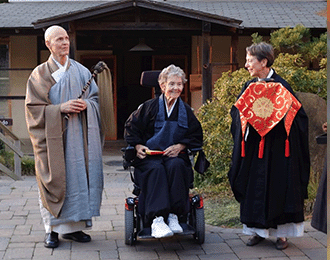Managing the Transition From Hospital to Rehab to Home

AARP – Updated for November 2021
Author: Amy Goyer
I’ve recently been helping a friend who has been managing her mother’s transitions from a hospital to a rehab facility, and then again to another rehab facility that wants to send her home before she, or her family, is ready. It reminded me of how tough family caregiving transitions can be. As a longtime family caregiver of many including both parents and my sister, I’ve been through many of them — some smooth, others unexpected and rocky. Caregivers play a crucial role in easing transitions, helping to ensure that loved ones adjust and get appropriate care along the way.
Moving our loved ones from one care setting to another is stressful for everyone involved. It’s invariably complicated and confusing, and I’ve often experienced poor communication among hospitals, facilities and family caregivers. Family caregivers play a key role in preventing hospital readmissions. We are the one consistent part of our loved ones’ care teams. Yet, all too often, family caregivers feel left out of the transition process. That’s why it’s up to us to be proactive.
When faced with a care transition, planning is key, even if you have only a few days. Here are some ways you can help your loved ones with care transitions:
1. Do your homework ahead of time.
It’s a good idea to be aware of the hospitals and rehabilitation, skilled nursing and assisted living facilities in your parent or other loved one’s immediate area. Talk with your parents about their preferences, goals and wishes about where, if needed, they would want to be treated, recover and live. Review the ratings of Medicare-certified facilities at the Medicare Compare site, and talk with family members of people who have been there. A little bit of basic research ahead of time will lower your stress levels in a crisis when you may need to make decisions quickly.
2. Start planning for discharge at the beginning of a stay at a hospital or rehabilitation facility.
Don’t wait until discharge is imminent. Ask to speak with a hospital discharge planner or social worker for help planning your loved one’s next steps, care, transportation to their next place, insurance coverage and payment plans.
Get help.
If you’re unable to manage all aspects of the transition due to being at a distance or other responsibilities, consider enlisting the help of a geriatric care manager or aging life care expert, or a case manager associated with their insurance.
Determine location and costs.
The goal is for your loved ones to be as independent as possible for as long as possible, so consider their quality of life, goals, current abilities (mobility, cognitive functioning) activities of daily living (ADLs) and instrumental activities of daily living (IADLs, like driving), rehabilitation, safety and care needs. What is the best place for them right now? Observe them in physical therapy sessions; talk with doctors, therapists and those who have been helping with personal care. Determine insurance coverage and out-of-pocket costs. Make the best decision you can with the information and resources you currently have.
• Transition to a rehabilitation facility, skilled nursing, assisted living facility or group home: Ask which facilities would be best for your loved ones’ specific needs in terms of on-site services provided, staff-to-patient ratio, type and frequency of rehabilitation services (acute, subacute, skilled nursing, etc.), transportation provided, activities and meals. Consider current visitation rules, location and ease for family and friends to visit. Evaluate the steps the facility is taking to protect residents from COVID-19. If possible, make an unscheduled visit to the facility and get a feel for cleanliness, residents’ happiness and staff attitudes. Request that the discharge planner facilitate the transition.
• Transition to their home or a family member’s home: Prepare the home and arrange for in-home services. Ask the physical and occupational therapy departments or a certified aging-in-place specialist to help you evaluate the home for safety. Review the AARP HomeFit Guide to help you determine if home modifications are needed, such as installing ramps, handrails, lighting, grab bars, etc. Obtain medical equipment (such as a wheelchair, walker, cane, oxygen, shower chair, raised toilet seat) and determine insurance coverage. Try to have these things in place prior to discharge. The discharge planner can help you find home-based medical services and understand insurance coverage for services like primary care, laboratory services, X-rays and therapies (such as physical, occupational or speech therapy). Your loved ones may initially be eligible to receive short-term home health aides and other services covered by Medicare, but you’ll need a plan for future care. Contact the local area agency on aging to ask about caregiver support and affordable home- and community-based services and ask for an in-home assessment.
3. Advocate for them … and for yourself.
In any transition, you’ll be advocating for your loved ones, ensuring they are informed as appropriate, that plans are in their best interests, and that they receive the best care along the way.
Check admission status. If your loved one is in the hospital using Medicare, find out if they are under “observation status” and how that could affect Medicare coverage if they are discharged to a rehabilitation facility.
Understand discharge timing. If you believe your loved one is being discharged too soon, whether they aren’t ready or you haven’t had enough time to set up their next location, don’t be intimidated. You can file an appeal. Talk with the insurance company and the hospital or facility social worker or hospital admissions office about the appeals process.
Monitor care and communication. Ensure that medical records and information about your loved ones’ conditions, treatments, medications and care needs are being shared between the hospital, facilities and care providers. Never assume communication or transfer of medical records has taken place. Confirm adherence to discharge plans and instructions.
Be there. Research indicates that patients do better with follow-up if a family caregiver is there to hear and note discharge instructions for medications and care. So make it your business to be there — either in person or virtually, via video chat or phone — for each transition. If you are unable to do so, make sure to arrange for a care manager, family member or friend to be present.
Insist on the three “I’s”: information, inclusion and instruction.
• Information: Obtain printed copies of all pertinent information, including the loved ones’ current medications list and prescriptions (flag any changes), and a summary of their visit (diagnosis, treatment, prognosis, surgeries, limitations, etc.), rehabilitation recommendations and discharge orders. Note any scheduled follow-up appointments. Share this information with those who will care for your loved ones next (doctors, facilities, home health aides, professional caregivers, etc.).
• Inclusion: Proactively make certain that you are included in care planning discussions and are informed of changes and decisions. If you have health care power of attorney for your loved ones, you can make decisions for them.
• Instruction: Nearly half of family caregivers are expected to perform follow-up medical and nursing tasks, so be sure to ask for detailed instructions/training (which is required by law in some states). When my dad was discharged from the hospital with a feeding tube, I was given just a few minutes of explanation on how to deal with it. It was complicated, and we were back in the hospital multiple times when it clogged. I received help from the home health nurses, but you can bet the next time we had a hospitalization I advocated more strongly for the information I needed to do my job as a caregiver.
4. Get realistic about the future.
Sometimes hospitals or rehab/nursing facilities are unrealistic about what setting is best for our loved ones, or how much a family can handle in terms of future care. It’s up to you to stay rooted in reality. I’ve learned to ask a lot of questions, observe loved ones in therapy sessions, monitor their medications and assess their capabilities, and weigh it all along with their needs, wishes and quality of life. I assess the home situation and potential facilities realistically. If you can’t provide all the direct care yourself, you are not a failure. You are still doing your job as a caregiver when you coordinate the care. As I often say, I’ve learned that I can do anything, but I cannot do everything! Line up the support you’ll need from care managers, care providers, family members and friends. Build your team.
Throughout the transition, make it a high priority to take care of yourself. I’ve experienced a lot of anxiety, stress and exhaustion during these transitions, especially after a long hospitalization when I spent 24/7 at the hospital with my loved ones. I’ve learned the hard way that I must build in time for self-care or else I will invariably crash. While some transitions go more smoothly than others, no transition is perfect. Just do your best with the information you can gather; you can make new decisions as the situation changes.
Care Transition Checklist
• Contact discharge planner/social worker
• Discuss options/plans with patient
• Talk with health care practitioners and therapists
• Arrange for next step in care:
– Facility: Visit; review care provided, residents, visitors, meals, cleanliness, certifications, ratings, complaints, costs and insurance coverage
– Home: Understand insurance coverage of home-based care; arrange for home modifications, medical equipment, personal care, medical care, therapies, meals, transportation, visitors/socialization, prescriptions
• Get printed medication list, prescriptions and discharge instructions
• Get hands-on demonstrations/instruction on medical/nursing tasks; photos/videos
• Get appropriate clothing and personal supplies
• Arrange for transportation upon discharge
• Ensure transfer of medical records between facilities/providers prior to, at time of and following the transition





